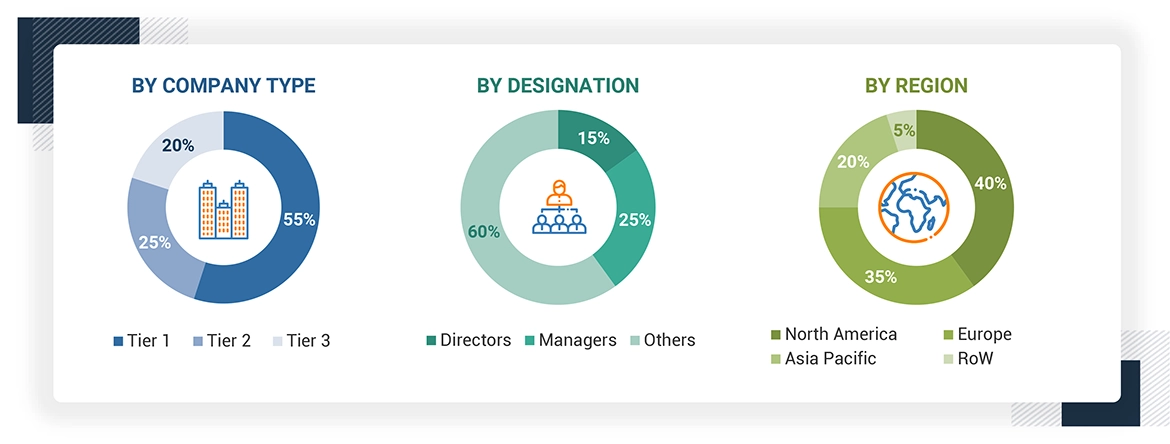This research study involved the extensive use of secondary sources—directories and databases such as Bloomberg Businessweek and Factiva—to identify and collect information useful for a technical, market-oriented, and commercial study of the smart food packaging market. In-depth interviews were conducted with various primary respondents—such as key industry participants, subject matter experts (SMEs), C-level executives of key market players, and industry consultants—to obtain and verify critical qualitative and quantitative information as well as to assess prospects.
Secondary Research
Secondary research for the smart food packaging market involved sourcing data from various reputable organizations and industry bodies to gather critical insights. Key sources included food safety authorities, packaging associations, and technology research institutions. Secondary research for the smart food packaging market relied on gathering data from several reputable industry and regulatory organizations. Key sources included the Food Packaging Forum, the Flexible Packaging Association (FPA), and the Institute of Packaging Professionals (IoPP) to understand packaging innovations, sustainability trends, and safety standards. Additional data were collected from market reports, white papers, and certified publications focusing on active and intelligent packaging technologies, sustainability trends, and consumer behavior. Industry journals, press releases, and investor presentations from major market players helped track product developments and competitive strategies. Paid databases and trade directories were also consulted to gather statistical data on market segmentation, key growth regions, and emerging technologies. This research provided a comprehensive understanding of the current market landscape and future trends shaping the smart food packaging industry.
Primary Research
The primary research for the smart food packaging market involved engaging key stakeholders across the supply chain to gather both qualitative and quantitative insights. This included raw material suppliers, equipment manufacturers, and smart packaging technology providers. On the supply side, interviews were conducted with smart food packaging manufacturers and technology developers, while on the demand side, primary sources included distributors, retailers, food producers, and end consumers. The objective was to understand the market dynamics, challenges, and opportunities driving adoption, as well as the future outlook for smart packaging technologies in the food industry.

To know about the assumptions considered for the study, download the pdf brochure
Market Size Estimation
Both the top-down and bottom-up approaches have been used to estimate and validate the total size of the smart food packaging market. These approaches were extensively to determine the size of the subsegments in the market. The research methodology used to estimate the market size includes the following details:
Smart Food Packaging Market : Top-Down and Bottom-Up Approach
Data Triangulation
After arriving at the overall market size from the estimation process explained above, the total market was split into several segments and subsegments. The data triangulation and market breakdown procedures were employed, wherever applicable, to estimate the overall smart food packaging market and arrive at the exact statistics for all segments and subsegments. The data was triangulated by studying various factors and trends from the demand and supply sides. Along with this, the market size was validated using both the top-down and bottom-up approaches
Stakeholders
-
Raw Material Suppliers
-
Food Packaging Manufacturers
-
Food and Beverage Companies
-
Retailers and Distributors
Report Objectives
MARKET INTELLIGENCE
-
To determine and project the size of the smart food packaging market with respect to the packaging type, application, functionality, material and region, over five years, ranging from 2024 to 2029.
-
To identify the attractive opportunities in the market by determining the largest and fastest-growing segments across the key regions
-
To analyze the demand-side factors based on the following:
-
Impact of macro-and micro-economic factors on the market
-
Shifts in demand patterns across different subsegments and regions.
COMPETITIVE INTELLIGENCE
-
To identify and profile the key market players in the smart food packaging market.
-
To determine the market share of key players operating in the smart food packaging market
-
To provide a comparative analysis of the market leaders based on the following:
-
Product offerings
-
Business strategies
-
Strengths and weaknesses
-
Key financials
-
To understand the competitive landscape and identify the major growth strategies adopted by players across the key regions.



Growth opportunities and latent adjacency in Smart Food Packaging Market